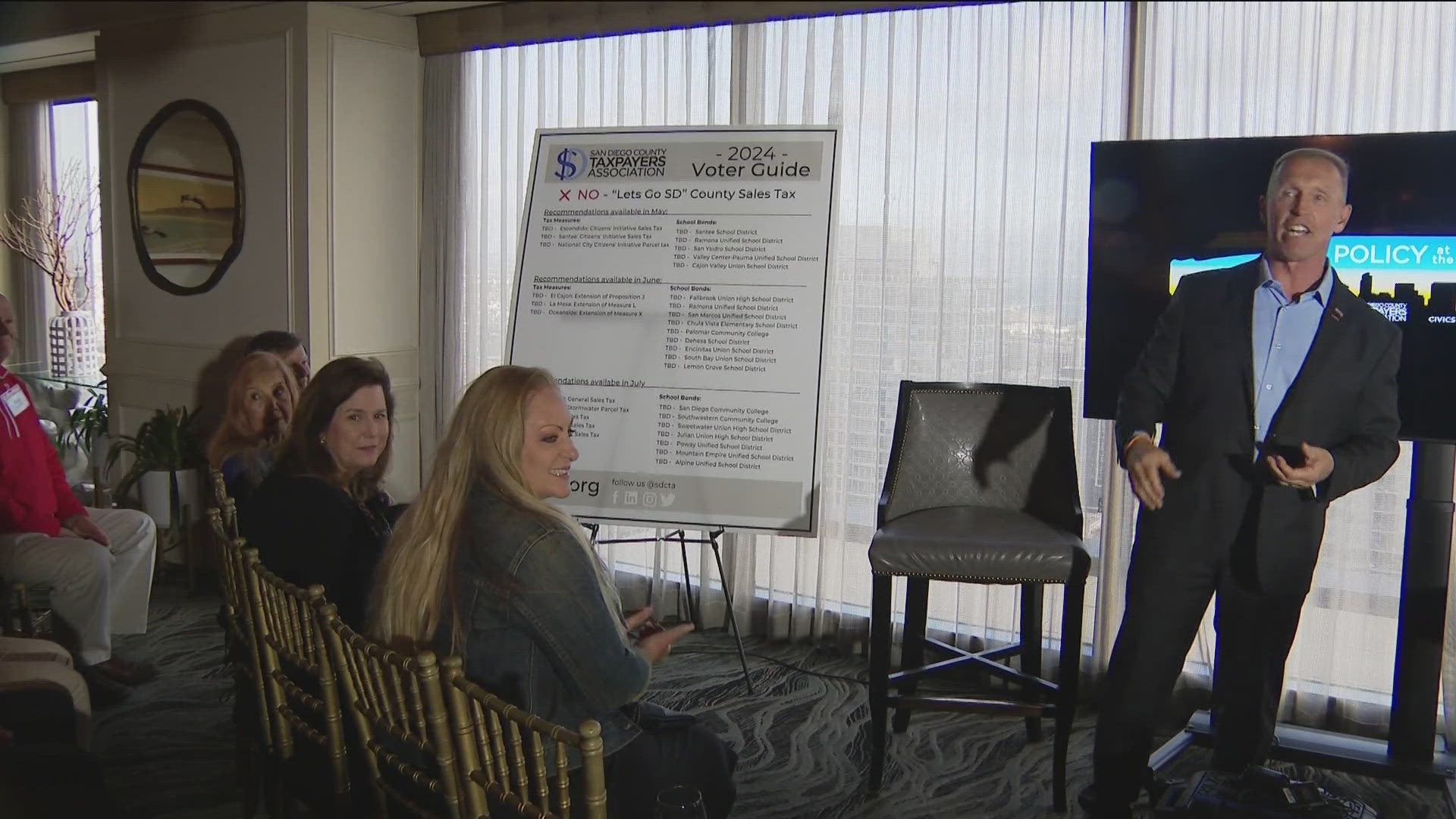CALIFORNIA, USA — This story was originally published by CalMatters.
As Dixie Samaniego prepared for her first semester at California State University Fullerton, she had one focus: finding a way to pay.
“I knew that my family wasn’t going to be able to pay, or help in any way financially,” said Samaniego, now a senior, “so I started applying to scholarships everywhere.”
As a low-income student, she qualified for a federal Pell Grant and a state Cal Grant, but still had a substantial balance to cover. After hours of applying, writing essays, and interviewing, she received a $5,000 award for her first year from a private foundation that aimed to help students who faced barriers to college.
But then, Samaniego said, she got some unwelcome news from Cal State Fullerton’s financial aid office: Adding the scholarship to her financial aid package would reduce the amount of aid she was getting from the university.
Confused and disappointed, Samaniego decided not to accept the scholarship she’d worked hard to earn.
“I didn’t know a single thing about higher education. I didn’t know a single thing about financial aid,” said Samaniego, who is the first in her family to attend college. “I got all this money, and then I had to make some really difficult decisions.”
What Samaniego says she experienced has a name: scholarship displacement. The practice occurs when a student receives a scholarship after their initial financial aid award and their college or university reorganizes their institutional aid package, often leading to a net zero gain for the student. And starting next fall, it will be banned in California for low-income students who qualify for a Pell Grant or for state financial aid under the California Dream Act.
California is one of five states in the U.S. with such laws, and only the second in the nation to bar scholarship displacement at both public and private colleges and universities.
It’s difficult to quantify how many students scholarship displacement affects, or how much money they lose. But a 2013 study by the National Scholarship Providers Association found that 20% of colleges nationwide reduce institutional grants when a student earns a private scholarship, even if a student still has demonstrated need. Advocates for low-income students say the practice can be a significant barrier to college affordability.
A spokesperson for Cal State Fullerton said federal privacy law prevented the university from commenting on a specific student’s financial aid package. But the Federal Student Aid office’s guidelines instruct universities and colleges to re-negotiate financial aid awards if there is a possibility of funds exceeding either the cost of attendance or the student’s need as demonstrated on their Free Application for Federal Student Aid. The rules also give financial aid officers some discretion in working with students to package their awards, however, and colleges have their own policies that they follow in addition to federal law.
“Inside the financial aid office, the details are more complex,” said Christina Tangalakis, president of the California Association of Student Financial Aid Administrators. “Some students are very successful in their college funding searches and are offered more assistance than they have costs to support” under the federal government’s methodology, Tangalakis said. But schools vary in their response to so-called “overawards,” she said.
Complicating the issue is the debate over whether colleges are accurately calculating the cost of attendance in California, where living expenses have skyrocketed in recent years. Colleges and universities are required by the government to provide “reasonable” estimates for costs accrued during a school year, according to the Federal Student Aid Handbook. Most schools use averages of expenses in a region when calculating estimated costs for housing, transportation and supplies, which can skew the results.
Yet it’s exactly those non-tuition expenses that place the heaviest burden on students. A 2021 study on college affordability by the Public Policy Institute of California concluded that “for a majority of students attending public postsecondary institutions in California, the combined cost of housing, fees, books, and transportation is greater than tuition.”
“We believe that California leads the nation in providing financial aid to students… but the total cost of education, and specifically the non-tuition costs, are being unmet by financial aid programs. So students have to rely on external sources,” said Marcos Montes, policy director for the Southern California College Attainment Network.
With the new law, Montes said, students will be able to maximize the use of scholarships. ”A student can use that money to pay for their housing, their books, their food, transportation, a new device, a new computer.”
Montes, himself, dealt with the stress of scholarship displacement while an undergraduate at California State University Los Angeles. Schools often calculate different costs of attendance for students based on their living situations. As a commuter student living at home, Montes was in the lowest category for cost of attendance. But he still needed money for textbooks and car maintenance.
“I was receiving a scholarship as a student government representative,” said Montes. “And when that scholarship hit, I was expecting a check of money to come to me so that I can use it to cover some non-tuition expenses, and that check was not coming.”
The school’s financial aid office told him he had maxed out on the amount of aid the school was willing to offer, Montes said. To access the funds, Montes was forced to move out of his parents’ home and change his residency status. He was able to use the scholarship – though not in the way he’d intended.
“I found, you know, a little one-bedroom place where I could live, and I used that money to pay for rent,” he said.
Before the law’s passage, Southern California College Attainment Network and other advocacy organizations were already working one-on-one with students who faced scholarship displacement.
Counseling those students can take hours and requires studying the financial aid award letter, understanding which dollars have been displaced, and working with counselors to find strategies to recover the funds. And not all students even realize what has happened to their financial aid package, or know where to go for help, said Mer Curry, executive director of the Northern California College Promise Coalition.
“It’s inefficient to be (advocating) student by student, but it’s also inequitable,” Curry said. “What we were finding from students is that they felt lucky, privileged, they were in a program, or had someone that explained to them what the issue was so that they could even go through a process of advocating or asking for help.”
Cal State Student Association president Krishan Malhotra said he didn’t receive any explanation from his university’s financial aid office when he lost $5,500 in aid after getting a stipend for his work in student government – money he was counting on to pay for digital textbooks.
“I keep track of my money pretty well,” said Malhotra, “But when you have a million things going on, when you have a full-time job, when you’re taking 18, 15 units, some students have families or dependents, and there’s so much going on, you can definitely miss it.”
Malhotra called the conversation about scholarship displacement “long overdue.”
The new law, passed by the Legislature in August and signed by Gov. Gavin Newsom, will allow the most vulnerable students who are able to secure additional funds for post-secondary education to have more freedom in how they use their funds.
The Cal State Student Association worked with advocacy groups to pass the law, and the California community college system signed on in support. Scholarship providers, frustrated that their funds were not always reaching the students who needed them, also weighed in.
“Scholarships play an integral role, not only with increasing access, but reducing student loan debt,” said Mike Nylund, president and CEO of Scholarship America, a Minneapolis-based nonprofit that helps students find and manage scholarship funds. “This new law will ensure that those students most in need will not lose their critical private scholarship funds.”
Tangalakis said the new rules might cause confusion at first, but would ultimately cause some schools to reprioritize aid policies to accommodate scholarships.
“Students will benefit from more consistent treatment of scholarship funds, and fewer adjustments to their institutional funding,” she said.
The scholarship displacement ban does leave out some students, however: those who aren’t low-income enough to qualify for Pell Grants or the California Dream Act, but still might have financial need.
“The bill has limitations. It doesn’t apply to everyone,” said Sbeydeh Viveros-Walton, director of higher education for Public Advocates, a nonprofit law firm that backed the bill. And students will still need to be informed about the issue so they can monitor their financial aid packages and ensure colleges are complying, she said. “It still puts the burden of fixing this on students.”
With the bill set to start protecting low-income students during the 2023-24 academic year, its sponsors are eager to ensure those students are educated and prepared.
“I think next is focusing on the implementation,” said Samaniego. “Figuring out if these bills, and these efforts, are actually reaching the students that they were intended to reach.”
CALmatters.org is a nonprofit, nonpartisan media venture explaining California policies and politics
Story is a fellow with the CalMatters College Journalism Network, a collaboration between CalMatters and student journalists from across California. This story and other higher education coverage are supported by the College Futures Foundation.



